Gaming GPU Market Size
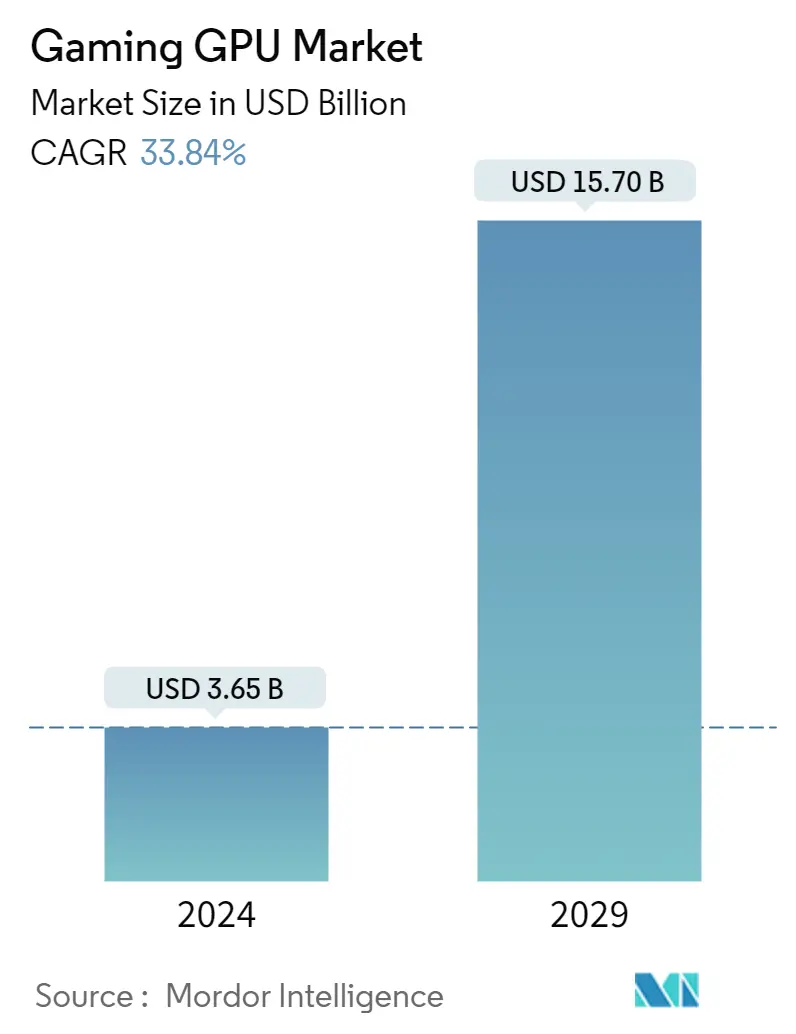
| Study Period | 2019 - 2029 |
| Market Size (2024) | USD 3.65 Billion |
| Market Size (2029) | USD 15.70 Billion |
| CAGR (2024 - 2029) | 33.84 % |
| Fastest Growing Market | Asia-Pacific |
| Largest Market | North America |
Major Players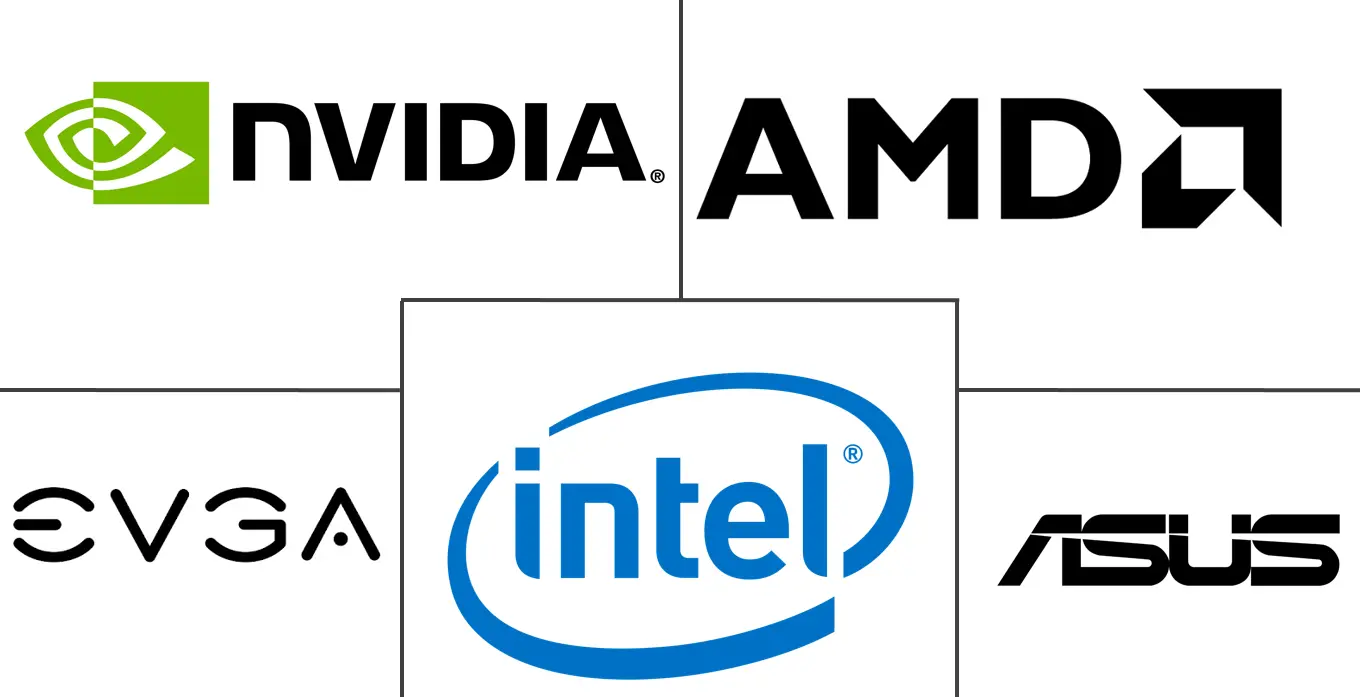
*Disclaimer: Major Players sorted in no particular order |
Gaming GPU Market Analysis
The Gaming GPU Market size is estimated at USD 3.65 billion in 2024, and is expected to reach USD 15.70 billion by 2029, growing at a CAGR of 33.84% during the forecast period (2024-2029).
The rising gamification trend among millennials has led to the increasing adoption of a virtual world for video gamers. Gaming machines have also evolved from powerful location-based devices found in restaurants, arcades, and bars to in-home machines in the form of gaming consoles and then PCs. As Moore's Law drove down chip prices and increased performance, people bought more gaming machines for the home, which has a positive price elasticity effect at the expense of location-based gaming machines. As gaming machine sales have increased in the last few years, the demand for gaming GPUs has grown significantly.
- The demand for high-end computing systems for graphics-intensive gaming applications has increased with the rising adoption of smartphones, tablets, PCs, and consoles for gaming purposes. The growing demand for specialized processors that can handle complex mathematical calculations related to the 2D and 3D graphics required for gaming drives the GPU market demand.
- Technological advancement in high-performing computing may also develop an opportunity for GPU vendors. For instance, in April this year, Nvidia stated that researchers discovered trends in Hubble data on April 25 using a supercomputer with NVIDIA GPUs. Also, high-performance computing is used with NVIDIA GPUs to increase the understanding of all planets and analyze their torrid atmospheres.
- Other drivers for the market include industry verticals such as automotive, manufacturing, real estate, and healthcare, with the rising usage of processors to support graphics applications and 3D content. For instance, in manufacturing and design applications in the automotive sector, CAD and simulation software uses GPUs to create realistic images and animations for critical applications.
- Gaming GPUs use advanced technologies and materials. One of the primary factors contributing to the high price of current GPUs is higher manufacturing expenses. Only the materials that producers can afford can be produced. Producers are thinking of maximizing their profits without sacrificing a product's quality or quantity due to rising manufacturing costs, which cause a rise in the selling price of the GPU. Due to this huge initial investment, consumers prefer to use something other than the latest gaming GPU in their devices, which is a challenge for market growth.
- Modern-day video game consoles and servers utilize many components, including gaming GPU circuits. COVID-19 threatened the average production of many of these components due to supply chain problems. However, semiconductor foundries started resuming production, which motivated manufacturers in the market. Demand in cloud computing, gaming, data center servers, automation, and AI technologies could help GPU manufacturers revive growth in the later part of the pandemic.
Gaming GPU Market Trends
This section covers the major market trends shaping the Gaming GPU Market according to our research experts:
Rising Demand for Gaming Consoles, Augmented Reality (AR), and Virtual Reality (VR) in the industry are Driving the Market
With the increasing adoption of esports and other types of online gaming, video games on consoles are rising and will show more growth opportunities in the coming years. As a result of this trend, connectivity and entertainment providers could target console gamers by offering console-related video services offerings, like fast broadband and live sports, and optimally monetizing the audience through OTT services. Video game developers could provide premium pricing for gaming subscription services, including access to esports events and original content.
- With the rising trend of cloud gaming, the GPU market has seen an upward trend in recent years. Blade, the French startup behind Shadow, is a cloud computing service for gamers that allows a player to access a gaming PC in a data centre for a monthly subscription fee. The company provides full Windows 11 features compared to other cloud gaming services. The company currently offers a single configuration for USD 35 per month with eight threads on an Intel Xeon 2620 processor, an Nvidia Quadro P5000 GPU, and an Nvidia GeForce GTX 1080, 12GB of RAM, and 256GB of storage.
- Further, major game developers are also focusing on developing console-based games with high graphic quality, contributing to the gaming segment's growth. Sony and Microsoft prioritize refresh rates up to 120 fps instead of trying to market the consoles as 8K capable, making the gaming experience seamless. Nvidia is trying to move beyond 4K with its monster RTX 3090 graphics card, which delivers 8K gaming for PCs.
- Console developers are also focusing on new product development to raise the bar for the competition in the market. Sony is aiming for 10.28 teraflops of performance, which is almost 15% less than the Xbox Series X. There are also some fundamental differences in cooling and architecture that allow Sony to offer variable GPU and CPU speeds, while Microsoft sticks to the more traditional fixed speeds and is very close to Sony in terms of 4K performance.
- The increasing incorporation of AR and VR in various applications is expected to drive the adoption of GPUs. Due to improvements in graphics technology, it is now possible to achieve true AR or VR and create a compelling user experience. Many companies are developing VR solutions primarily to redefine the way people experience computing and gaming, and the companies are also developing GPU systems for AR and VR applications.
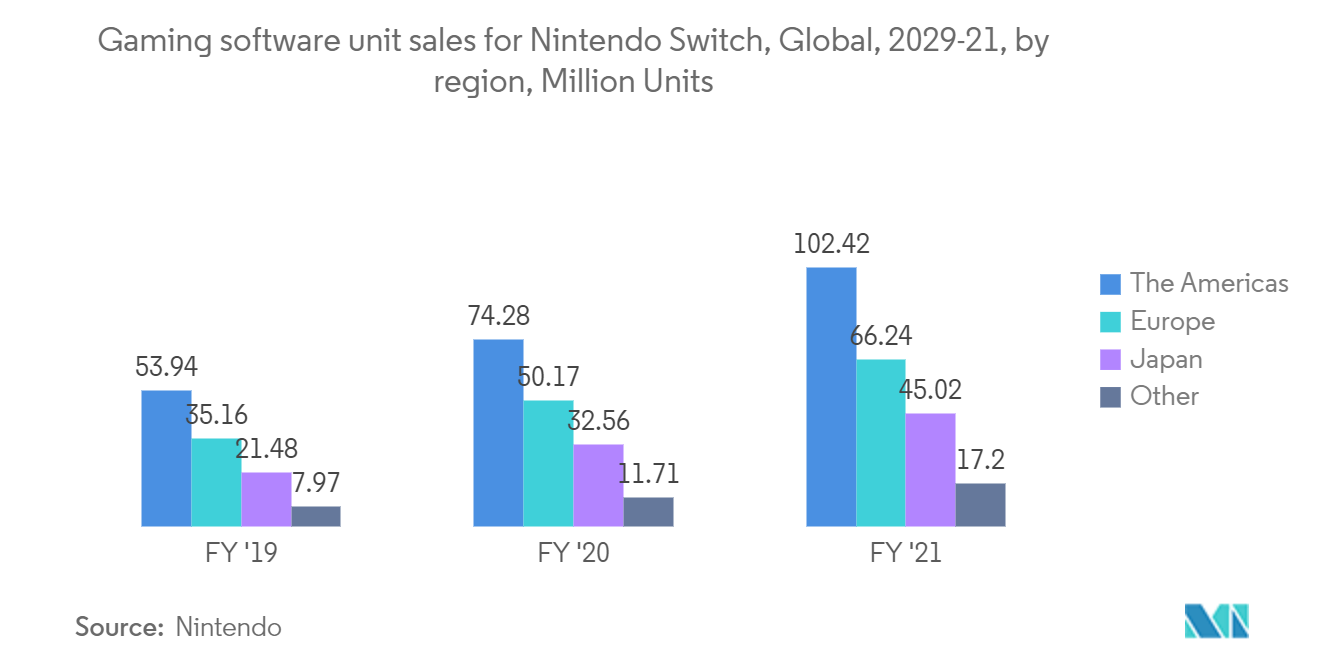
North America is Expected to Hold a Significant Share
The rise in gaming among millennials in the North American region has been dramatic and swift in the past few years. In the United States, over 30% of video gamers pay for gaming subscription services, and more than 35% play online video games at least once a week, according to Limelight Networks.
- Major technology developers are investing in online gaming in the North American gaming market, further bolstering the region's market growth. In January of this year, Microsoft, an American MNC, announced plans to acquire Activision Blizzard Inc., a prominent player in game development and interactive entertainment content publishing. This acquisition may accelerate the growth of Microsoft's gaming business across mobile, PC, console, and cloud and is expected to drive demand for the company's Xbox offerings.
- Additionally, in March of this year, Intel launched the Arc series of Graphics Processing Units (GPU) for laptops and desktop PCs. Laptops with the Arc 3 GPU, designed for enhanced gaming and content production, are available for pre-order, while laptops with the Arc 5 and Arc 7 GPUs, designed for advanced and high-performance gaming, will come later in the current year.
- Cloud gaming companies benefit from collaborating with telecoms to develop better end-to-end networks and encourage 5G adoption in the region. The need for telecoms to increase their upstream capacity to meet the demands of esports players is a further driving force, and various vendors are collaborating to meet their gaming needs.
Gaming GPU players in the region also focus on developing GPU products, further driving the region's growth. For instance, in July last year, AMD introduced the AMD Radeon RX 6600XT series graphics products, harnessing the power of the AMD RDNA architecture while providing better performance with its 9.6 teraflops of RDNA 2 technology and 8 GB of GDDR6 RAM.
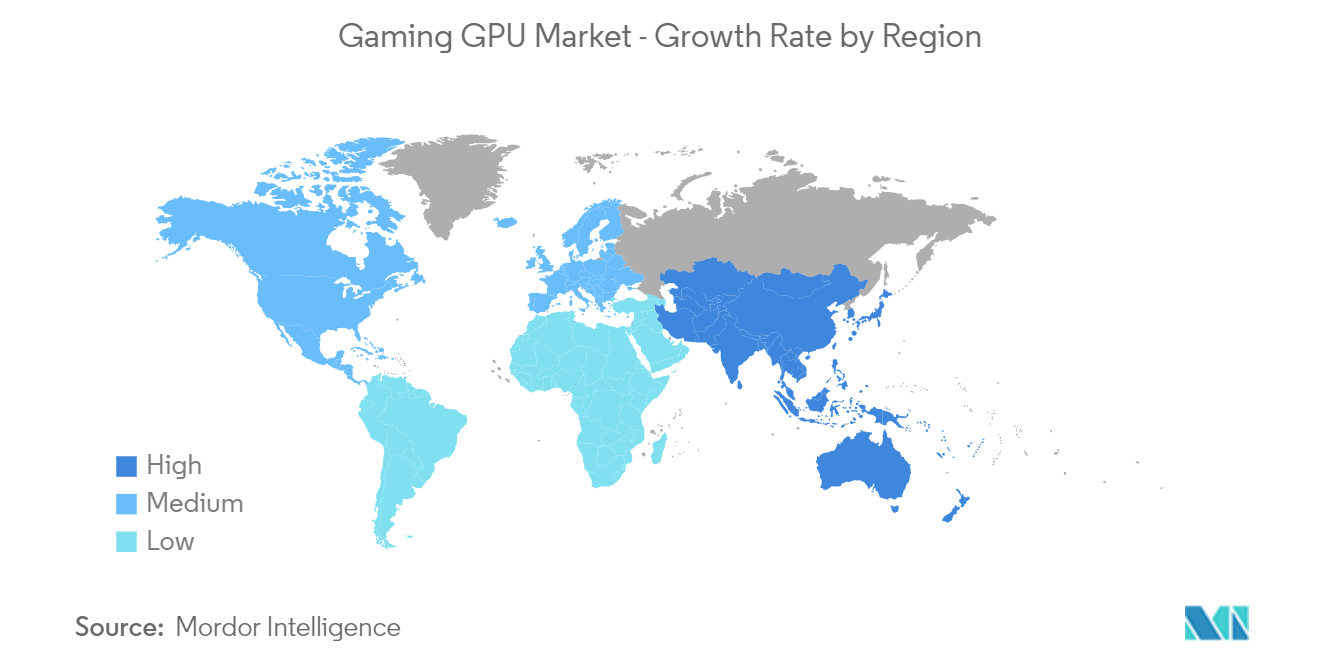
Gaming GPU Industry Overview
The gaming GPU market is significantly consolidated and consists of fewer global and regional players. These players account for a significant market share and focus on expanding their customer base globally. These vendors focus on research and development investment in introducing new solutions, strategic alliances, and other organic & inorganic growth strategies to earn a competitive edge over the forecast period.
In November 2022, ASUS updated its TUF Gaming GeForce RTX 3060 Ti and Dual GeForce RTX 3060 Ti graphics cards to include GDDR6X memory for better performance. The 3060 Ti's capabilities have been improved by the addition of GDDR6X RAM, which expands the options available to discerning PC DIY builders. ASUS has produced a new GeForce RTX 3060 with 8 GB of GDDR6 VRAM to increase the GPU's capacity for customization and assembly.
Gaming GPU Market Leaders
-
www.amd.com
-
www.nvidia.com
-
www.intel.com
-
www.asus.com
-
asia.evga.com
*Disclaimer: Major Players sorted in no particular order
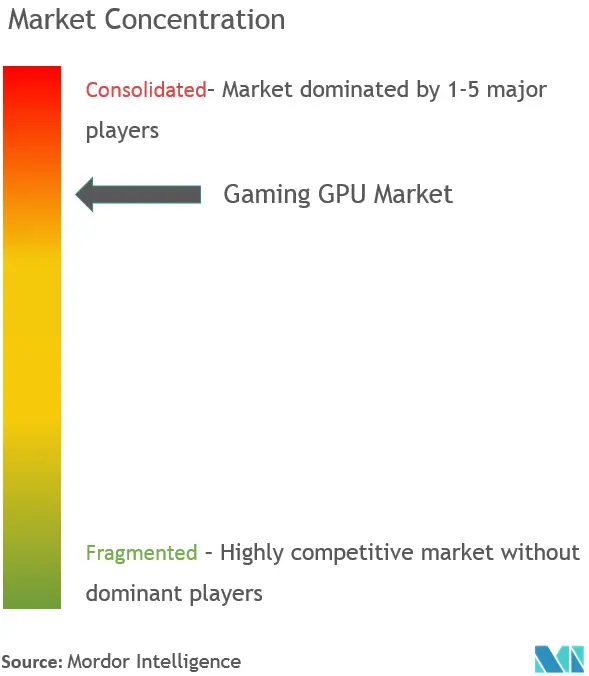
Gaming GPU Market News
- January 2023: NVIDIA introduced RTX 40 Mobile GPUs, promising laptop gamers performance on par with that of desktop systems. The business unveiled the GeForce RTX 4090 and GeForce RTX 4080. These GPUs are nonetheless very powerful even though the mobile versions are much smaller than the desktop counterparts. They can drive "3x 4K" monitors in Surround Gaming at 60 frames per second. That translates to 11,520 by 2160 pixels or over 25 megapixels. Further highlighting the usefulness of its powerful Ada GPUs for productivity applications, NVIDIA has developed its flagship-class RTX 40 GPU to provide "2X quicker video export."
- November 2022: AMD unveiled new graphics cards for high-end gaming based on the fast and economical RDNA 3 architecture. The company's new RDNA 3 architectures have been used for the first time in its RX 7900 XTX and RX 7900 XT graphics cards. According to the manufacturer, the new graphics cards also enable DisplayPort 2.1 displays, giving outstanding images and ultra-high frame rates at up to 4K 480Hz and 8K 165Hz refresh rates.
Gaming GPU Market Report - Table of Contents
1. INTRODUCTION
- 1.1 Study Assumptions and Market Definition
- 1.2 Scope of the Study
2. RESEARCH METHODOLOGY
3. EXECUTIVE SUMMARY
4. MARKET INSIGHTS
- 4.1 Market Overview
-
4.2 Industry Attractiveness - Porter's Five Forces Analysis
- 4.2.1 Threat of New Entrants
- 4.2.2 Bargaining Power of Buyers
- 4.2.3 Bargaining Power of Suppliers
- 4.2.4 Threat of Substitutes
- 4.2.5 Intensity of Competitive Rivalry
- 4.3 Industry Value Chain Analysis
- 4.4 Assessment of Impact of COVID-19 on the Industry
-
4.5 Market Drivers
- 4.5.1 Rising Demand for Gaming Consoles, Augmented Reality (AR), and Virtual Reality (VR) in the industry
- 4.5.2 Increasing Demand for Advanced Displays with Higher Refresh Rates
-
4.6 Market Restraints
- 4.6.1 High Initial Investment
5. MARKET SEGMENTATION
-
5.1 Type
- 5.1.1 Dedicated Graphic Cards
- 5.1.2 Integrated Graphics Solutions
- 5.1.3 Other Market Types
-
5.2 Device
- 5.2.1 Mobile Devices
- 5.2.2 PCs and Workstations
- 5.2.3 Gaming Consoles
- 5.2.4 Automotive
- 5.2.5 Other Devices
-
5.3 Geography
- 5.3.1 North America
- 5.3.2 Europe
- 5.3.3 Asia Pacific
- 5.3.4 Latin America
- 5.3.5 Middle East and Africa
6. COMPETITIVE LANDSCAPE
-
6.1 Company Profiles
- 6.1.1 Intel Corporation
- 6.1.2 Advanced Micro Devices Inc.
- 6.1.3 Nvidia Corporation
- 6.1.4 ASUSTEK Computer Inc
- 6.1.5 GIGA-BYTE Technology Co., Ltd.
- 6.1.6 Arm Limited
- 6.1.7 Qualcomm Technologies Inc.
- 6.1.8 Imagination Technologies Group
- 6.1.9 EVGA Corporation
- 6.1.10 SAPPHIRE Technology Limited
- *List Not Exhaustive
7. INVESTMENT ANALYSIS
8. FUTURE OF THE MARKET
** Subject To AvailablityGaming GPU Industry Segmentation
Gaming GPU is a specialized electronic circuit created to manipulate and change memory to speed up the production of images in a frame buffer intended for output to a display device. They are important for gaming applications because they can process many data simultaneously.
Gaming GPU Market is Segmented by Type (Dedicated Graphic Cards, Integrated Graphics Solutions), Device (Mobile Devices, PCs & Workstations, Gaming Consoles, Automotive), and Geography (North America, Europe, Asia Pacific, Latin America, and Middle East & Africa).
The market sizes and forecasts are provided in terms of value (in USD million) for all the above segments.
| Type | Dedicated Graphic Cards |
| Integrated Graphics Solutions | |
| Other Market Types | |
| Device | Mobile Devices |
| PCs and Workstations | |
| Gaming Consoles | |
| Automotive | |
| Other Devices | |
| Geography | North America |
| Europe | |
| Asia Pacific | |
| Latin America | |
| Middle East and Africa |
Gaming GPU Market Research FAQs
How big is the Gaming GPU Market?
The Gaming GPU Market size is expected to reach USD 3.65 billion in 2024 and grow at a CAGR of 33.84% to reach USD 15.70 billion by 2029.
What is the current Gaming GPU Market size?
In 2024, the Gaming GPU Market size is expected to reach USD 3.65 billion.
Who are the key players in Gaming GPU Market?
www.amd.com, www.nvidia.com, www.intel.com, www.asus.com and asia.evga.com are the major companies operating in the Gaming GPU Market.
Which is the fastest growing region in Gaming GPU Market?
Asia-Pacific is estimated to grow at the highest CAGR over the forecast period (2024-2029).
Which region has the biggest share in Gaming GPU Market?
In 2024, the North America accounts for the largest market share in Gaming GPU Market.
What years does this Gaming GPU Market cover, and what was the market size in 2023?
In 2023, the Gaming GPU Market size was estimated at USD 2.73 billion. The report covers the Gaming GPU Market historical market size for years: 2019, 2020, 2021, 2022 and 2023. The report also forecasts the Gaming GPU Market size for years: 2024, 2025, 2026, 2027, 2028 and 2029.
Gaming GPU Industry Report
Statistics for the 2024 Gaming GPU market share, size and revenue growth rate, created by Mordor Intelligence™ Industry Reports. Gaming GPU analysis includes a market forecast outlook to 2029 and historical overview. Get a sample of this industry analysis as a free report PDF download.



